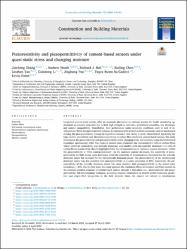Piezoresistivity and piezopermittivity of cement-based sensors under quasi-static stress and changing moisture

Göster/
Erişim
info:eu-repo/semantics/openAccessTarih
2024Yazar
Zhang, JiachengHeath, Andrew
Ball, Richard J.
Chen, Binling
Tan, Linzhen
Li, Guisheng
Pan, Jingbang
Su-Cadirci, Tugce Busra
Paine, Kevin
Üst veri
Tüm öğe kaydını gösterÖzet
Integrated cement-based sensors offer an economic alternative to extrinsic sensors for health monitoring applications in concrete structures due to their high strength to cost ratio, geometrical versatility, low shrinkage, and natural compatibility. Nonetheless, their performance under in-service conditions were in lack of investigations. While the piezoresistivity (change in resistance with stress) has been commonly used for mechanical sensing, the piezopermittivity (change in capacitive reactance with stress) is rarely characterized. Exploiting the high relative permittivity and electrical conductivity of carbon fibre reinforced cement-based sensors, this study investigates the piezoresistivity and piezopermittivity under changing stress and moisture using electrochemical impedance spectroscopy (EIS). Two types of sensors were evaluated: one containing 0.5 vol% of carbon fibres whose electrical conductivity was ionically dominant, and another with electronically dominant (1.2 vol% of carbon fibres) conductivity. Results highlighted that the piezopermittivity is “moisture content-dominant” whilst the piezoresistivity is “fibre content-dominant”. As the moisture content decreased, the sensitivity of piezopermittivity for both sensor types decreased, while the sensitivity of piezoresistivity decreased for the ionically dominant sensor but increased for the electronically dominant sensor. The piezoresistivity of the electronically dominant sensor was less sensitive than piezopermittivity at a water saturation of 80%. Conversely, the piezoresistivity of the ionically dominant sensor was more sensitive than piezopermittivity at the tested water saturations ≤ 80%. For the first time, this study presents the combined effects of moisture and fibre content on the pressure sensitive response of cement-based sensors through a dual-phase (i.e., piezoresistivity and piezopermittivity) EIS interpretation technique, providing valuable information to benefit further behaviour prediction and single-effect recognition in the field scenario where the sensors are subject to simultaneous environmental effects causing moisture variations such as temperature and humidity variations, freeze-thawing, and so on.

















